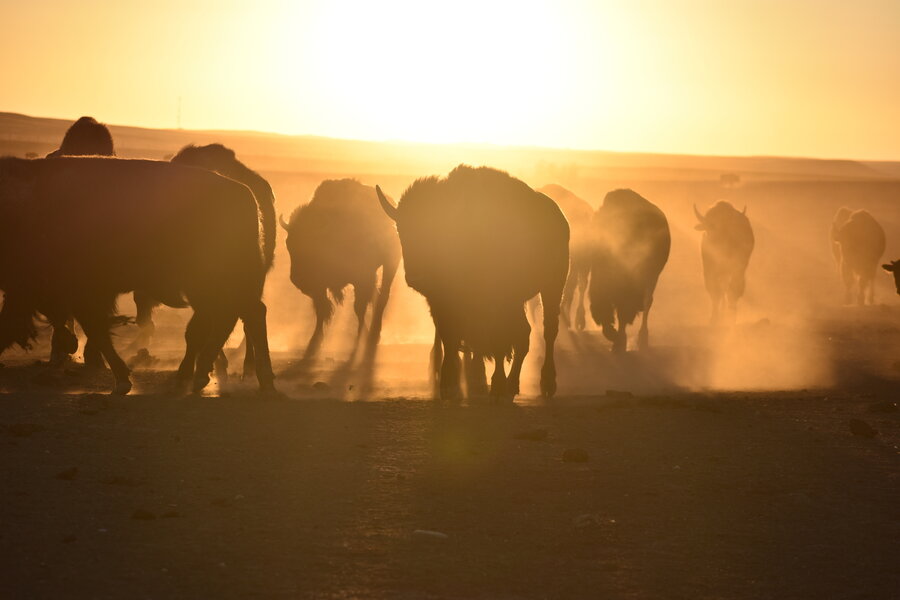Perched atop a fence at Badlands National Park, Troy Heinert peered from beneath his wide-brimmed hat into a corral where 100 wild bison awaited transfer to the Rosebud Indian Reservation.
Descendants of bison that once roamed North America’s Great Plains by the tens of millions, the animals would soon thunder up a chute, take a truck ride across South Dakota, and join one of many burgeoning herds Mr. Heinert has helped reestablish on Native American lands.
Mr. Heinert nodded in satisfaction to a park service employee as the animals stomped their hooves and kicked up dust in the cold wind. He took a brief call from Iowa about another herd being transferred to tribes in Minnesota and Oklahoma, then spoke with a fellow trucker about yet more bison destined for Wisconsin.
By nightfall, the last of the American buffalo shipped from Badlands were being unloaded at the Rosebud reservation, where Mr. Heinert also lives. The next day, he was on the road back to Badlands to load 200 bison for another tribe, the Cheyenne River Sioux.
“Buffalo, they walk in two worlds,” said Mr. Heinert. “Are they commercial or are they wildlife? From the tribal perspective, we’ve always deemed them as wildlife, or to take it a step further, as a relative.”
Now 82 tribes across the United States have more than 20,000 bison in 65 herds – and that’s been growing along with the desire among Native Americans to reclaim stewardship of an animal their ancestors depended upon for millennia.
European settlers destroyed that balance, driving bison nearly extinct until conservationists, including Teddy Roosevelt, intervened to reestablish a small number of herds.
The long-term dream for some Native Americans: return bison on a scale rivaling herds that roamed the continent in numbers that shaped the landscape itself. Mr. Heinert, a South Dakota state senator and director of the InterTribal Buffalo Council, views his job more practically: Get bison to tribes that want them, whether two animals or 200.
“All of these tribes relied on them at some point,” he said. “Those tribes are trying to go back to that, reestablishing that connection.”
Bison for centuries set rhythms of life for the Lakota and other nomadic tribes. Hides for clothing and teepees, bones for tools and weapons, horns for ladles, hair for rope – a steady supply of bison was fundamental.
At so-called “buffalo jumps,” herds would be run off cliffs, then butchered over days and weeks.
European settlers brought a new level of industry to the enterprise – and bison killing dramatically increased, their parts used in machinery, fertilizer, and clothing. By 1889, only about 1,000 remained.
“We wanted to populate the western half of the United States because there were so many people in the East,” U.S. Interior Secretary Deb Haaland, the first Native American cabinet member, said in an interview. “They wanted all of the Indians dead so they could take their land away.”
The thinking at the time, she added, was “if we kill off the buffalo, the Indians will die. They won’t have anything to eat.”
The Rosebud Sioux are intent on expanding the reservation’s herds as a reliable food source.
Others have grander visions: The Blackfeet in Montana and tribes in Alberta want to establish a “transboundary herd” ranging over the Canada border near Glacier National Park. Other tribes propose a “buffalo commons” on federal lands in central Montana where the region’s tribes could harvest animals.
“What would it look like to have 30 million buffalo in North America again?” said Cristina Mormorunni, a Métis Indian who’s worked with the Blackfeet to restore bison.
Ms. Haaland said there’s no going back completely – too many fences and houses. But her agency has emerged as a primary bison source, transferring more than 20,000 to tribes and tribal organizations over 20 years.
Transfers sometimes draw objections from cattle ranchers who worry bison carry disease and compete for grass. Yet demand from the tribes is growing, and Ms. Haaland said the transfers will continue. That includes about 1,000 bison trucked this year from Badlands, Grand Canyon National Park and several national wildlife refuges.
Back at Wolakota range, Mr. Heinert’s son T.J. sprinkled chewing tobacco along the back of the bison he’d just shot, and prayed. Then the half-ton animal was hoisted onto a flatbed truck for the ride to ranch headquarters.
About 20 adults and children gathered as the bison was lowered onto a tarp.
“This relative gave of itself to us, for our livelihood, our way of life,” said tribal elder Duane Hollow Horn Bear before a group assembled to butcher the animal.
Katrina Fuller, who helped guide the butchering, dreams of training others so the reservation’s 20 communities can come to Wolakota for their own harvest. “Maybe not now, but in my lifetime,” she said. “That’s what I want for everyone.”
This story was reported by The Associated Press. Video journalist Emma H. Tobin contributed to this report.
